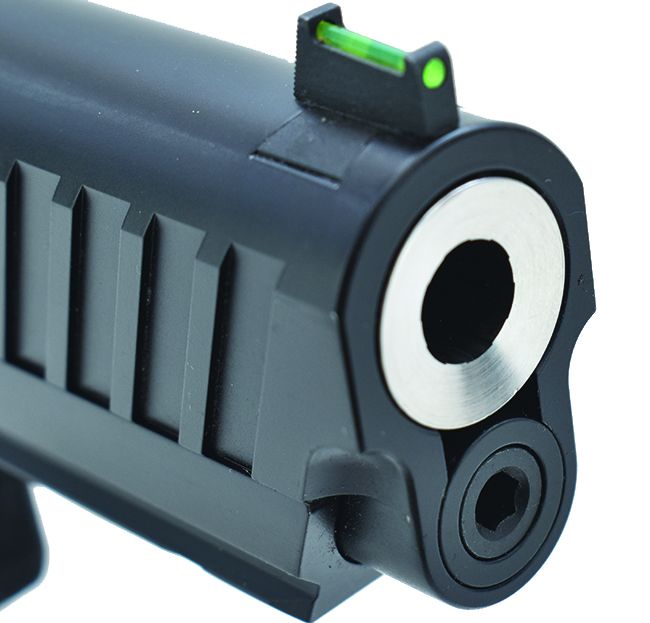Several 9mm models with double-stack magazines have really caught our eye recently. The first came from a new company called Cosaint. Our sample was a high-capacity COS21 with a Commander-length slide, an Officer’s Model–length barrel, and a bit of a compensator. It runs $2600. The next piece came from Rock Island Armory, the Model M1911 A2 FS-Tactical, $774. It uses a slightly older design, but it is built with modern production methods and comes in at an incredible price point. The third was the Springfield Armory Prodigy, $1650. Boasting features similar to other 2011-style pistols, the Prodigy gun itself is similar to a pistol we tested in the August 2023 issue, but this one was a package that comes with a Hex Dragonfly red dot, whereas the August gun was shot exclusively with a Crimson Trace CTS-1250. Because the Hex was a factory-installed optic, we wondered if it would improve the Prodigy’s downrange results beyond what the Crimson Trace dot could do.
This trio looks and feels like a 1911-style handgun, with one major difference. A 1911 in 45 ACP is a great pairing, but a standard magazine only holds seven rounds. Switching to a 9mm chambering adds a couple more rounds, but in this age of high-capacity 9mms, we want more than that.
Two Canadian gentlemen, Ted Szabo and Thanos Polyzos, brought us a great solution to the capacity problem at Para-Ordnance in the mid-1980s, with a 1911 top end mated to a double-stack-magazine-capable grip frame. The first generation of Para-Ord double-stack 1911s was bit large, but edges were rounded and bulk was trimmed, making the 2nd Gen a much more usable pistol. Also, STI (now Staccato) provided a major step in the evolution of the platform with a stainless-steel frame attached to a polymer grip module, and the 2011 was born.
Modern iterations retain the most important characteristics of Browning’s classic 1911 design, such as the 18-degree grip angle, superb trigger, and greatly improved sights, along with high-capacity magazines. Our three test guns in 9mm Luger have all these features. To see how they performed, we tested with 115-grain FMJ fodder from Winchester and Remington and a 124-grain FMJ round from Armscor. Our fourth round was a defensive choice, Hornady’s Critical Duty 124-grain +P. Function was perfect for all three of the pistols tested. We did not have a single malfunction in more than 1200 rounds fired. Here’s more on how they did.
Several 9mm models with double-stack magazines have really caught our eye recently. The first came from a new company called Cosaint. Our sample was a high-capacity COS21 with a Commander-length slide, an Officer’s Model–length barrel, and a bit of a compensator. It runs $2600. The next piece came from Rock Island Armory, the Model M1911 A2 FS-Tactical, $774. It uses a slightly older design, but it is built with modern production methods and comes in at an incredible price point. The third was the Springfield Armory Prodigy, $1650. Boasting features similar to other 2011-style pistols, the Prodigy gun itself is similar to a pistol we tested in the August 2023 issue, but this one was a package that comes with a Hex Dragonfly red dot, whereas the August gun was shot exclusively with a Crimson Trace CTS-1250. Because the Hex was a factory-installed optic, we wondered if it would improve the Prodigy’s downrange results beyond what the Crimson Trace dot could do.
This trio looks and feels like a 1911-style handgun, with one major difference. A 1911 in 45 ACP is a great pairing, but a standard magazine only holds seven rounds. Switching to a 9mm chambering adds a couple more rounds, but in this age of high-capacity 9mms, we want more than that.
Two Canadian gentlemen, Ted Szabo and Thanos Polyzos, brought us a great solution to the capacity problem at Para-Ordnance in the mid-1980s, with a 1911 top end mated to a double-stack-magazine-capable grip frame. The first generation of Para-Ord double-stack 1911s was bit large, but edges were rounded and bulk was trimmed, making the 2nd Gen a much more usable pistol. Also, STI (now Staccato) provided a major step in the evolution of the platform with a stainless-steel frame attached to a polymer grip module, and the 2011 was born.
Modern iterations retain the most important characteristics of Browning’s classic 1911 design, such as the 18-degree grip angle, superb trigger, and greatly improved sights, along with high-capacity magazines. Our three test guns in 9mm Luger have all these features. To see how they performed, we tested with 115-grain FMJ fodder from Winchester and Remington and a 124-grain FMJ round from Armscor. Our fourth round was a defensive choice, Hornady’s Critical Duty 124-grain +P. Function was perfect for all three of the pistols tested. We did not have a single malfunction in more than 1200 rounds fired. Here’s more on how they did.
Gun Tests Grade: A- (Our Pick)
$1650
Springfield Armory has been in the 1911 world for decades, but to this point, the company has primarily concentrated on single-stack designs. Being very familiar with their 1911 platform, we were very pleased to see their introduction of a high-capacity variant in late 2022. We were even more pleased to see them do so at a $1700 price point, which includes a Hex Dragonfly reflex red dot sight.
| Action Type | Semi auto, hammer fired |
|---|---|
| Overall Length | 7.75 in. |
| Overall Height | 5.75 in. |
| Overall Height w/optic | 6.25 in. |
| Maximum Width | 1.44 in. |
| Weight Unloaded | 2.2 lbs. |
| Weight Loaded | 2.8 lbs. |
| Slide | Carbon steel, optics cut |
| Slide Retraction Effort | 11.0 lbs. |
| Receiver | Carbon steel, Picatinny rail |
| Finish | Cerakote black |
| Front Strap Height | 3.0 in. |
| Back Strap Height | 3.25 in. |
| Barrel Length | 4.25 in. |
| Grip Thickness (Maximum) | 1.295 in. |
| Grip Circumference | 5.75 in. |
| Magazines | One 17 round; one 20 round |
| Rear Sight | Fixed black U-notch |
| Front Sight | Fixed green fiber optic |
| Sight Radius | 5.6 in. |
| Trigger Pull Weight | 4.3 lbs. |
| Trigger Span | 3.0 in. |
| Safeties | Thumb levers and grip |
| Warranty | Limited lifetime for original owner |
| Telephone | (800) 680-6866 |
| Website | Springfield-Armory.com |
| Made In | U.S. |
The new 1911 DS (double stack) Prodigy pistol comes in two barrel lengths: 4.25 and 5.0 inches. The shorter barrel should cycle a bit faster and be easier to maneuver in tight spaces. The longer version will be slightly slower to swing but brings the advantage of reduced muzzle flip. We were able to test drive a sample of each. While recognizing subtle differences, we liked both sizes. The shooter will have the enviable job of deciding which they like best.
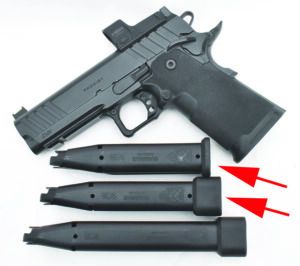
For the full test, we secured a 4.25-inch version. Even with the shorter barrel, Springfield puts a bit of weight out front. Instead of the traditional thin barrel secured by a bushing, Springfield uses a bull barrel that measured 0.700 inch at the muzzle. The stainless-steel match tube locked up very tightly, as did the rest of the top end. The slide (along with that beefy barrel) pushes the balance forward, using a slab-sided design for it and most of the dust cover. The frame has been reinforced to the point where the body of the slide stop virtually sits flush with the surface of the frame. There is a tiny bit of a relief cut on the front of the dust cover and the bottom of the slide that helped us get the Prodigy back into our Comp-Tac International holster ($74, Comp-Tac.com). The slide sports five grasping grooves at the rear and four on the muzzle end. Some folks disparage the forward cocking serrations, but we like them for doing a quick press check by squeezing the slide between thumb and fore finger then gently pressing to the rear.
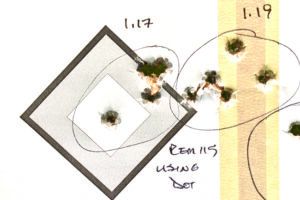
We ordered the Prodigy with the Hex Dragonfly already mounted because we wanted to get some experience with Springfield’s factory dot. We found the Hex Dragonfly to be very solidly mounted. The front sight is a green-fiber-optic tube in a dovetail mount. The rear is a serrated black panel, as we described in the August 2023 issue. We shot groups substantially larger with the irons on this gun than we did the August model, but the August Prodigy was shot only with red dots. This time, the Prodigy shot larger groups off the bench than did the Rock Island, and the Cosaint outshot the Springfield with three of the four rounds. The overall averages for the Prodigy were 1.73 inch with the Remington FMJs, 1.97 inch with the Winchester FMJs, and 1.96 inch with the Armscor FMJs. The Hornady 124-grain Critical Duty JHPs shot a 1.43-inch average. Also, we fired the Remington FMJs with the Hex red dot on and saw the average bench groups shrink from 1.73 inch to 1.18 inch. The latter measurement was very much on par with the August gun, which with the Crimson Trace dot fired average groups of 1.02, 1.06, 1.20, and 1.27 inches with different ammos than we used this round.
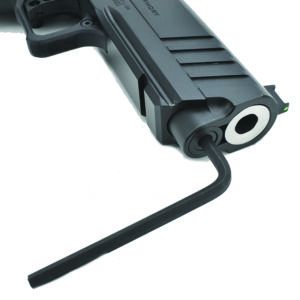
Our Houston shooters have tested quite the number of red-dot sights over the years, finding them to be substantial assistance to older eyes. One of the problems with their introduction has been establishing some kind of consistency with the mounting systems. We’ve contributed hours, dollars, and more than a few muttered expletives as we tried to attach different optics to different pistols. Springfield Armory machines its optics-ready models to match with the Agency Optic System (AOS). Using a common base, multiple plates are available that will allow most current red dots to work with their pistols. Our sample shipped with the Hex Dragonfly sight and the appropriate plate. More are available from the company (Springfield-Armory.com) and other sources. The AOS mount not only provides a secure platform for the optic but also allows the retention of the rear sight. The rear unit can be considered suppressor height, making it tall enough to co-witness with the front sight through the optic window. We ran many drills using the Hex sight and then tested the irons by leaving the Hex sight on with the dot turned off while we shot the speed drills. Worked fine, though shooting irons through the optic window will take some training by the owner. Note that the Cosaint pistol uses a system of similar design from C&H Precision Weapons.
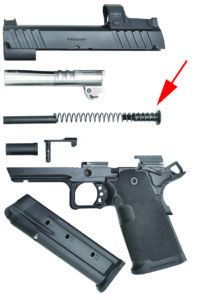
This optic provides a good-sized viewport with a protective cover that extends up and in front of the glass. Our standard practice is to operate the slide by pushing against the optic. Even when doing so enthusiastically, we found few residual hand prints on the glass, showing that the cover was doing its job. The elevation is on top of the rear deck and the windage is on the right side. The on/off/intensity button is of the left side. The battery mounts underneath the unit, so it must be removed to change, but that shouldn’t be a problem. Using a 16-hour auto-off helps the Dragonfly achieve an estimated 100,000-hour run time (three years) with a CR2032 battery. At 3.5 minutes-of-angle size, the dot is a good compromise between accuracy and speed. It has an IPX7 waterproof rating, and the electronics have a five-year limited warranty. Suggested retail is $249, and that seems to be the street price as of this writing. The AOS mounting plate worked great and kept everything nice and snug. The Dragonfly requires the Springfield Armory standard pattern, which would also work for a Vortex Venom or a Burris FastFire.
No longer the mono-body part to which we have become accustomed, the lower portion of the Prodigy receiver uses a steel frame with a polymer grip attached. Attachments points are at the top of the trigger guard and where we would normally find the top grip screw. Think of the frame more as a cradle into which the standard parts fit or on which they hang. The trigger, slide stop, thumb safety, grip safety, and all the fire-control group are attached to the frame. The only moving part we can see purely in the polymer frame is the magazine release. The checkered mainspring housing sits, as would be expected, in the frame. To date, we have more than 800 rounds through the gun with nary a malfunction.
The grip sports a squared-off trigger guard that is cut high to allow the shooter’s hand a bit higher purchase on the pistol, obviating muzzle flip a bit. The magazine well is slightly flared front and rear. The side panels are pretty square, because, we would think, there just isn’t enough material left in the narrow grips to allow further thinning while maintaining structural integrity. Don’t get us wrong here — thin is good, especially on what some might use as a carry gun. The thinner grips also translate into a smaller overall grip circumference, which is greatly appreciated by testers with less than monster-sized hands. The ambidextrous thumb safety is big enough to find and activate without being obnoxious. The beavertail grip safety was high and smooth while providing a tall memory bump. The grip safety on a good 1911 should not be difficult to deactivate — unless you have small hands or unless you have less than beefy palms. In any case, there is a tall memory bump to help the shooter make proper contact with the safety. Kudos to Springfield Armory for the assist. We found the right-side lever of the ambidextrous grip safety could be a bit less than positive to activate. This required that we position our thumb directly and firmly over the top of the lever before we tried to push it straight down for deactivation.
The polymer insert on the grip sports texturing that is a Springfield Armory creation. First introduced with the Hellcat pistol, the points on the grip are arranged in two layers. The first is comfortable with a casual grip and is very easy to shift in the hand. The second deeper layer comes into play when the shooter holds the pistol tightly, as when shooting. We found the difference to be noticeable as well as effective and liked the concept.
The skeletonized, alloy trigger was very crisp, with very little overtravel. Required compression was just over 4.3 pounds. It could have been a bit lighter, as on the Cosaint. Our sample arrived with 17-round and a 20-round magazines marked as being made by Duramag. The Springfield Armory store has more of these, as well as a 26-round mag available for $60 each.
Our Team Said: The Prodigy’s list of features is very complete, and the price is good. We think the Prodigy is worthy of being compared to more expensive 2011s. If you have a favorite optic, then choose the PH9117AOS version we tested in August and add your own red dot. If you want an optic that’s factory-installed, then pick the PH9117AOSD reviewed here and enjoy the Hex Dragonfly.
9mm Luger Range Data
Our shooters fired these pistols at American Shooting Centers in Houston. We shot them for accuracy at 15 yards by firing multiple five-shot groups from a sandbagged Caldwell Pistol Rest and a Mini DRC Fortune Cookie from Wiebad.com. We used a LabRadar chronograph to measure velocities.
| Remington 115-grain FMJ | Springfield Prodigy | Cosaint COS21 Commander | Rock Island Armory FS-Tactical |
| Average Velocity | 1147 fps | 1128 fps | 1196 fps |
| Muzzle Energy | 336 ft.-lbs. | 325 ft.-lbs. | 365 ft.-lbs. |
| Best Group | 1.49 in. | 1.52 in. | 1.07 in. |
| Average Group | 1.73 in. | 1.79 in. | 1.46 in. |
| Winchester 115-grain FMJ | Springfield Prodigy | Cosaint COS21 Commander | Rock Island Armory FS-Tactical |
| Average Velocity | 1104 fps | 1062 fps | 1159 fps |
| Muzzle Energy | 311 ft.-lbs. | 288 ft.-lbs. | 343 ft.-lbs. |
| Best Group | 1.47 in. | 1.20 in. | 1.10 in. |
| Average Group | 1.97 in. | 1.45 in. | 1.38 in. |
| Armscor 124-grain FMJ | Springfield Prodigy | Cosaint COS21 Commander | Rock Island Armory FS-Tactical |
| Average Velocity | 1060 fps | 1026 fps | 1071 fps |
| Muzzle Energy | 309 ft.-lbs. | 290 ft.-lbs. | 316 ft.-lbs. |
| Best Group | 1.73 in. | 1.50 in. | 0.96 in. |
| Average Group | 1.96 in. | 1.83 in. | 1.33 in. |
| Hornady | Springfield | Cosaint | Rock Island Armory |
| 124-grain Critical Duty | Prodigy | COS21 Commander | FS-Tactical |
| Average Velocity | 1177 fps | 1095 fps | 1223 fps |
| Muzzle Energy | 382 ft.-lbs. | 330 ft.-lbs. | 412 ft.-lbs. |
| Best Group | 0.79 in. | 1.44 in. | 1.46 in. |
| Average Group | 1.43 in. | 1.66 in. | 1.49 in. |
Drill Data (5x5x5)
Process: Fire five shots from draw at a 5-inch circle placed at 5 yards. Numbers are averages for two repetitions.| Pistol | Time to First Shot (seconds) | Split Average (seconds) | Total Time (seconds) |
|---|---|---|---|
| Springfield Prodigy | 1.36 | 0.20 | 2.160 |
| Cosaint COS21 Commander | 1.395 | 0.230 | 2.310 |
| Rock Island FS-Tactical | 1.570 | 0.264 | 2.625 |
Drill Data (5x7, A ZONE)
Process: Fire five shots from draw at A-zone plate (5-by-11 inches) at 7 yards. Numbers are averages for two repetitions.| Pistol | Time to First Shot (seconds) | Split Average (seconds) | Total Time (seconds) |
|---|---|---|---|
| Springfield Prodigy (irons) | 1.335 | 0.1990 | 2.13 |
| Springfield Prodigy (red dot) | 1.2 | 0.201 | 2.005 |
| Cosaint COS21 Commander | 1.255 | 0.205 | 2.075 |
| Rock Island FS-Tactical | 1.380 | 0.204 | 2.195 |
DRILL DATA (5x8, A ZONE)
Process: Fire five shots from draw at A-zone plate (5-by-11 inches) at 8 yards. Average of five draws from holster.| Pistol | Total Time (seconds) |
|---|---|
| Springfield Prodigy (irons) | 1.210 |
| Springfield Prodigy (red dot) | 1.298 |
| Cosaint COS21 Commander | 1.238 |
| Rock Island FS-Tactical | 1.342 |



























